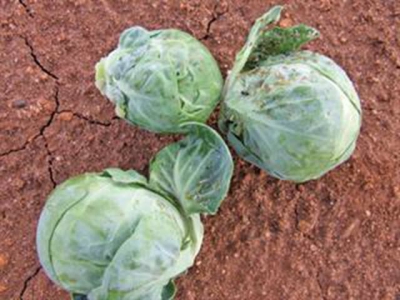Growing Brussels sprouts

Brussels sprouts is a luxury item not part of our daily cuisine and usually reserved for special treats. It is generally well known that this crop is a dedicated winter crop requiring cold for good performance.
One of the two main aphid species which attacks Brussels sprouts. Photo: Bill Kerr
This fact has often been a hindrance to those who plant the first time as, with this information in mind, they tend to sow the seed too close to winter resulting in less than optimal performance. On the other hand, if you plant too early, the sprouts developing on the lower part of the stem will tend to become loose and unmarketable. There’s also a variety issue here.
For one thing, certain varieties tend to form loose sprouts more easily than others, while some are bred to produce firm sprouts in warmer conditions and mature earlier. This makes it possible to extend the season by planting two varieties. The size of sprout can also vary considerably between varieties and you need to determine the market requirements in this regard.
Timing
Sowing is best done in midsummer so that transplanting can be done in January. This allows the plants to develop sufficiently before the heavy cold sets in. This is not to say that the plants are frost sensitive – quite the contrary. But if the planting date is too late, growth slows down and the sprouts are then positioned too close to one another on the stem.
As they try to develop, they’re compressed against one another and become flattened rather then round. Not only does this diminish appeal, it also makes harvesting more difficult. The young plants should also be encouraged to grow as quickly as possible with well-timed applications of nitrogen and good practices. This helps the plant to become tall enough to set a good crop with the sprouts well spaced on the stem.
Insect pests
The main hazard in producing Brussels sprouts is keeping insects out of the sprouts. If you haven’t grown this crop before you’ll be surprised to find just how attractive developing sprouts are to insects – and how difficult they are to control. Timing and vigilance are important here. In the first place, being a tall and leafy plant, it is difficult to get the spray mixture to make contact with the sprouts.
Breeders have started to breed varieties with cupped, rather than flat, leaves to make penetration through the leaf canopy easier. But for now, a sprayer with drop arms works very well as it blasts the droplets directly onto the sprouts. In order to do this with some conventional sprayers, you have to use substantially more spray.
Regular checks
As the plants grow taller, the lower leaves are shaded out. Apart from becoming more prone to disease, they also make it more difficult to wet the sprouts as they deflect the droplets. It’s better to remove them at this point. This will also allow more airflow, which reduces the likelihood of diseases developing on the sprouts. There are two main pests – thrips and two species of aphid. These tend to move into the sprouts when they’re still loose and developing and remain there, well protected from insecticide spray.
It is thus vitally important to do regular checks for these pests from an early stage and adapt your spray programme so that they don’t get a foothold. If you want, you can break out the tops of the plants for a more concentrated harvest as this causes the upper sprouts to develop more rapidly. You’ll sacrifice some yield, but it may be expedient to do so from a labour point of view, or where the land is required for another crop at this time.
When breaking off older leaves, consider removing the loose lower sprouts at the same time. Not only are they unmarketable, if left they could become a source of insect build-up. They must be sprayed to the end if not removed.
Có thể bạn quan tâm
 Know your seedling needs
Know your seedling needs Vegetable seedlings vary quite a bit, so make sure you tell your seedling grower what you need.
 How to harden seedlings
How to harden seedlings Seedlings need to be hardened to enable the plants to survive in the new environment where they are planted. hardening has another advantage.
 Understanding spray mixtures
Understanding spray mixtures With spray adjuvants, many farmers think that mixing a sticker and a wetter/spreader into the water are the same thing. This is certainly not true.